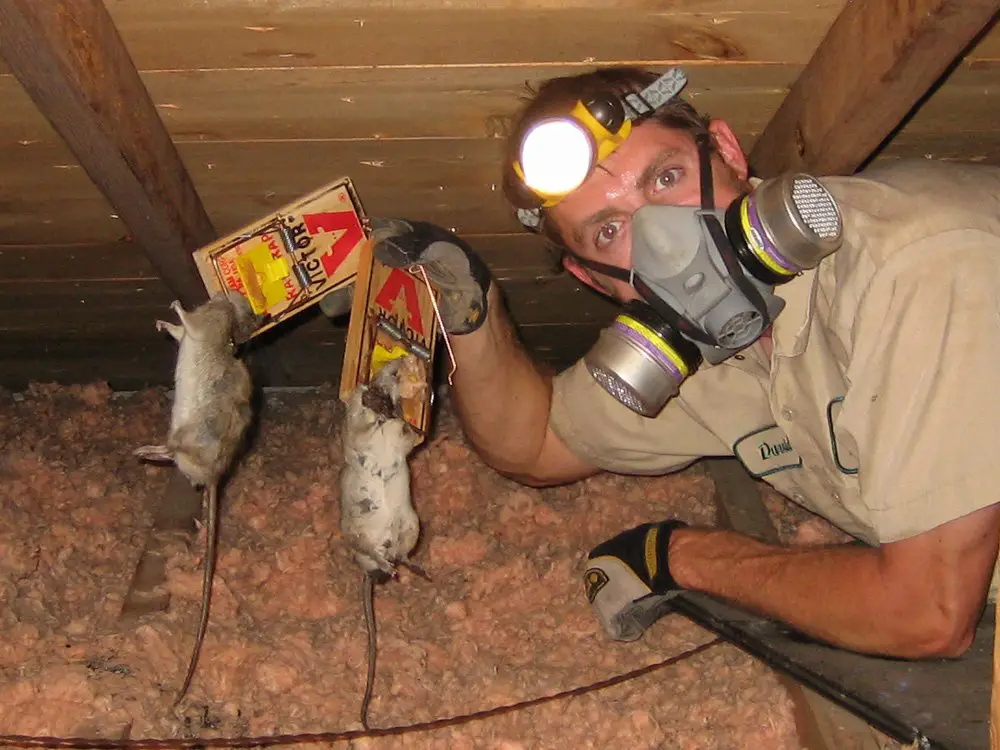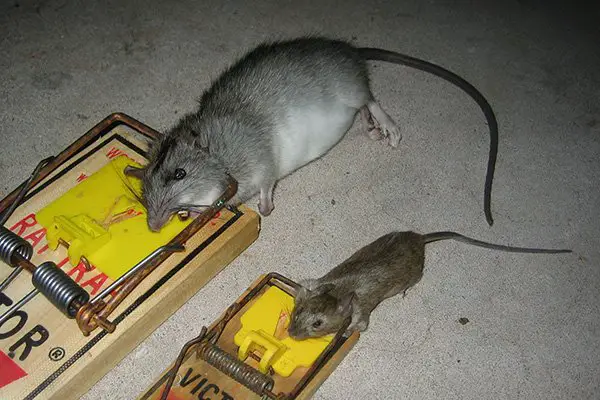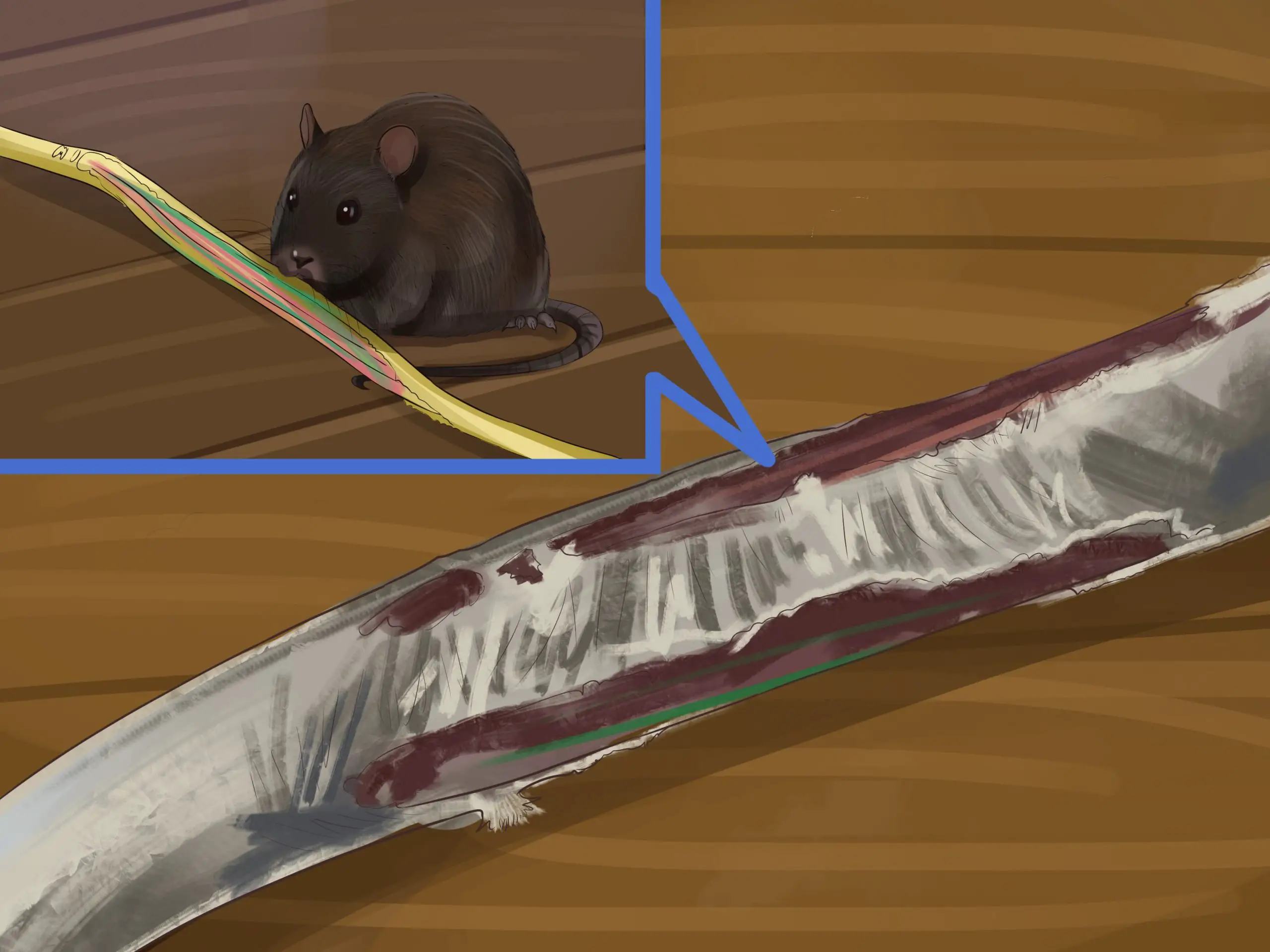Rats Wont Go Near Traps
If you still cant catch a rat in the attic, its likely because they are happy with the food they are getting outside and arent interested in the bait you put on your traps.
Since there is food source in your attic roof rats leave nightly to get their food outside. Some of their favorite outdoor food sources are mangos, bird seeds, nuts, and garbage.
Successful rat removal requires sealing the entry points on the outside of the house to prevent them from getting back inside in the future. This is called rodent proofing or rodent exclusion. If you successfully can seal all the rodent entry points, the ones trapped inside will get hungry and will be forced to go for your traps.
Make sure to put enough traps in your attic! Since there are usually between 5-10 roof rats in a family, we recommend placing at least 12 traps in the attic. All the time we see people only putting out a few traps. This will lengthen the time it takes to trap all of the rats.
In a worst case scenario, rats that dont get caught in your traps will get desperate and chew their way out of your soffit vents or other entry points, foiling your rodent exclusion.
Rat Zapper Pros And Cons
A rat zapper is a type of trap that kills rats by administering a strong electric shock.
The rat zapper should be placed close to a roof rat nest or in their runways,” said Ernie Henson, president and owner of Stormin Norman Termite and Pest Control. “Roof rats can be cautious when new items are introduced into their environment. You want to make sure to limit human scent when placing a trap, zapper or baits to control rodents.
Rat zappers can be a high-maintenance way to control rats.
The rat zapper works well, but more frequent re-inspections are required than with other methods. It should be checked every other day, or even daily,” Henson said.
“This makes the rat zapper impractical for pest control companies to utilize because of the time commitment required. Once trapped, the rat needs to be removed before decomposition starts. If the rat starts to decompose on the rat zapper, it will most likely have to be replaced, making the rat zapper a very expensive trap.
One advantage of a rat zapper, Henson said, is that it is easy to set up and use. Disadvantages include the cost per trap, which averages $40-$60 each, the time commitment required for inspection, and the fact that the rat zapper ideally would be used only indoors.
The rat zapper is an electronic device. If it gets wet, it can make it inoperable. They are not recommended for the exterior because of this,” Henson said.
READ MORE
Remove Food And Water Sources
Birdbaths, bird feeders, and garbage cans set up close to the house may lure roof rats to those locations. Placing the items further away may deter them from entering. If you own fruit trees, clean up fallen fruit periodically to prevent pests from setting up a home in the yard. If there are any outdoor water and food dishes for pets, relocate them to a place where roof rats cant reach. Ensure any pet food is placed in sealed containers.
Roof rats do not have to be a serious problem. Sealing up entry points along the roof, cutting back tree branches, and eliminating food sources can prevent them from entering your home. If you suspect damage to your roof from roof rats, contact Diversified Roofing right away.
Also Check: Garage Roof Trusses
Do Roof Rats Cause Diseases
Yes Roof rats spread diseases through their droppings, urine, and saliva. They can contaminate food and other items with their droppings or through chewing due to bacteria in their mouths. Roof rats transfer diseases from either contamination, droppings, physical contact, wounds, or fleas that have bitten roof rats.
Signs Of An Infestation Of Roof Rats

You wont always see roof rats because they are nocturnal and forage for food at night. However, you need to know the signs of infestation that can alert you to their presence. Once found, you can take the proper control measures.
One of the most obvious signs of infestation is roof rat droppings. Roof rat droppings are smaller than those of Norway rats. The droppings are about 0.5 in long with pointed ends. Other signs of a roof rat infestation include:
- Gnawing or scratching noises in the attic or walls
- Gnaw marks around the homes roof or eaves
- Spotting them running on tree limbs, power lines, roofs, patios and in fruit trees
- Hollowed-out fruit if you have fruit trees
- Gnawing damage to electrical wires in the home
- Pets showing signs of stress and agitation
- Grease trails and marks as they travel regular routes through the home
- Nests found in the insulation of your home
Once inside, the roof rat population can grow rapidly. A female can have a litter of five to eight babies. In warm, tropical regions, roof rats breed year-round, and females can have up to three litters a year.
Recommended Reading: How Far Apart Should Screws Be On Metal Roof
Rodent Control In West Palm Beach Fl
Now that you know what roof rats sound like, you may know there is in fact a rodents in your attic. But what next? Sure, you could go to the store and buy some rat traps and poison, but it will be much easier if you simply contact us.
Native Pest Management is your local rodent control and pest control company in South Florida. We service all of Palm Beach, Broward, , St. Lucie and Miami Dade counties. With over 1000 five star reviews on Yelp, Google, HomeAdvisor, Nextdoor, and Angie’s list, we are the top rated rodent control company in the West Palm Beach, FL area.
Call today to schedule your FREE rodent control inspection to reclaim your home from rats and mice.
How Long Does It Take To Get Rid Of Rats
It generally takes roughly 3 days to one week to get rid of rats with rat poison. Mechanical traps can sometimes take a few days to trap rats because the rodents may be wary of the trap. A pest control professional can remove rats in as little as one day to a few days depending on the size of the infestation.
Don’t Miss: Repair Roof Trusses
How Do Roof Rats Get Into A House
- Roof Rats frequently enter homes and garden sheds through any opening larger than a nickel
- They follow pipes down from the attic, sneak through doggie doors, gnaw through drywall and enter kitchens, bathrooms or base sink cabinets
- They chew through wood, plastic, aluminum siding, and dry wall
- These rodents are fond of attics because they provide a safe refuge and a nesting place for their young
- Roof Rats have been known to enter the sewer system through the roof vent pipes
Getting Rid Of Roof Rats: 3 Great Tips
Pests, bugs, rodents, and the like can be a real pain for homeowners. Everything from cockroaches to termites, which cause about $30 billion in damages to man-made structures each year, can give you and the rest of your family nightmares, both in the nocturnal and financial sense.
Roof rats, specifically, are one of the worst rodent problems to have for a homeowner. Here are some great ways to rid your home or any and all roof rats:
Don’t Miss: Roof Cost California
What Do Roof Rats Look Like
Roof rats are 13 to 18 inches in length, including the tail. They weigh between five and nine ounces and have slender bodies, pointed snouts, big eyes and large, almost hairless ears.
They are nocturnal and active within a territory of 200 to 300 feet from their nesting locations. Black rat colonies can range from three to four individuals up to several hundred.
Are Roof Rats Nocturnal
Roof Rats are most active between dawn and dusk, which is most likely when they will be heard if you have an infestation. Capable of squeezing into spaces smaller than half an inch, these nocturnal critters love to nest in trees, attics, roof lines and ceilings, as they prefer living more than four feet off the ground where they build leafy nests for their young.
Don’t Miss: Metal Roof Skylight
Other Animal Noises In The Attic
You came to this post in search of an answer to the question What do roof rats sound like? Hopefully with the above information youve identified the culprit as roof rats and are well on your way to getting the rats in the attic removed and locked out permanently.
If the noises you are hearing are clearly from a larger animal, it could be raccoons in the attic or opossums in the attic. We have dealt with both. With either of these animals, youll likely hear larger thumping and walking sounds. Since both have to leave the attic to access food and water, youll likely hear at night when that happens.
Recently we have removed ducks from attics Like other animals, ducks will lay eggs in the warmth of attic insulation if they are able to access your attic.
Another potential source of animal noises if you are in a South Florida city like Fort Lauderdale, FL or West Palm Beach, FL are from iguanas on your roof. Yes, we said that, iguanas on your roof. We have often found iguanas enjoying the warmth from the sun on areas roofs, and they can be quite noisy as they are moving around up there.
If you do indeed have these other animals in your attic or on your roof, we recommend calling your best local widlife and rodent control company at Native Pest Management, or by reading how to safely remove raccoons or opossums from your attic.
Keep Your House Clean And Tidy

Pests enjoy clutter and will happily live in a place with a lot of it. Thats why you need to keep your property clutter-free. Remove any piles of newspapers and wood away from your home. Clean your home thoroughly at least once a week. If your attic is full of old cardboard boxes, consider getting rid of them.
Also Check: Skylight Installation Metal Roof
Why Do Roof Rats Inhabit Attics
Roof rats prefer to stay off the ground, and are said to spend most of their lives elevated at least 4 feet off the ground. In their natural habitat, roof rats nest high in trees. However, roof rats are adaptable and resilient and will move into shrubs, wood piles and other lower locations that provide shelter.
Attics are high, dark, warm, and rarely disturbed areas. Attics offer security from the elements and predators. An attic is an ideal space for roof rats to set up a warm home, store food, and raise a family.
How To Catch A Rat Ways To Catch Rodent
Catching rats isn’t like catching other animals. You can’t snare a rat, the way you can snare a raccoon. You can’t just go grab a rat by the tail, the way you can do to an opossum. Cage traps aren’t as successful with rats as they are with other animals. Realistically, the most likely way you’re going to catch a rat is via trapping.But remember, the first step is crucial – you must seal up the building first, so all the entry and exit holes are shut before you start catching rats. To try to catch them without doing so is pointless. Once it’s all sealed, no more rats can get in, and the ones that are stuck inside with no way out become much easier to catch.Here are some tips on how to catch rats effectively.
Also Check: New Roof Cost California
Its True: Roof Rats Cause Fires
Not only are roof rats extremely dangerous because of disease transmission, they also can cause extreme damage both physically and financially. Rodents chew on electrical wires, which causes the wire to be exposed. When the wires exposed, it may come in contact with insulation or other materials and this can ignite a fire.
What Attracts Rats In Your House
So, youre probably pretty convinced that you dont want rats in your peaceful home. But do you know what attracted them to your house in the first place? Some key factors that tempt these rodents:
- Poor Sanitation
Rats dont just appear out of nowhere. If they are present, then they have easy access to food and water sources. You should always keep your roof area clean because these rodents can be attracted by every bit of garbage scattered throughout the house.
- Safety and comfort
Rats are warm-blooded animals, so they seek a warm, comfortable place to nest. They will stay inside your roof space for as long as its tiny holes provide them protection and shelter.
- Food, food, food
Your recently discovered roofmates arent picky eaters. In fact, they will gladly feed on every piece of food they find. You should keep the areas where food is prepared and consumed clean and free of unprotected leftovers or crumbs.
Don’t Miss: Exposed Fastener Metal Roof Screw Pattern
Get Creative With Smelly Bait And Rat Attractants
One of the reasons why you find rats luring in damp, moldy places is because they love the smell. If you put a stinky cheese like Limburger on your trap, it will be more attractive. They love to eat wood and cardboard too, so keep in mind their preferences when capturing them.
Another trick that you can use is to invest in a product called rat breath odor. Its an attractant that lets them know that its a friendly space for them. A rat doesnt want to get into danger, so they sniff to see if other vermin have frequented it. You can only use a tiny amount to lure them to the traps. Overdoing it can cause the opposite effect. If you want to keep rodents out of an area, then use these attractants.
Live And Snap Trap Pros And Cons
Live traps are not the smartest options for elimination of roof rats. A professional should be called to avoid disease and to ensure proper disposal, said Sage Garvey, director of technical operations at Burns Pest Elimination in Phoenix.
Snap traps traps that break the animals neck and kill the animal are the best option because an exterminator can determine the gender and age of the rat to determine if there are more to eliminate.
If a homeowner catches a rat with a live trap or a snap trap, disposal becomes a problem.
You could not move a rat to a different location because that is illegal. Instead, you would have to make sure that it is euthanized and throw it in your trash can, Garvey said.
As for the pros of live traps, Garvey said, homeowners would know that they have caught the pest.
For the cons, you could end up getting bit in the disposal/retrieval process, which is dangerous because rats carry at least 60 communicable diseases.
Garvey said exterminators can make routine checks of live traps and dispose of any rats caught.
If a homeowner chooses to purchase a live trap, we can come out to dispose of the rat that is captured if the homeowner is unable to or decides they don’t want to, he said.
Also Check: Shingling A Shed
Catching A Norway Rat Vs A Roof Rat
The methods used for catching a Norway Rat versus a Roof Rat are as different as they are different species and therefore need two widely different approaches. The Norway Rat and the Roof Rat are two of the most common species found in Canadian homes all across the country. The Norway Rat is primarily found close to the ground and underground as they usually dig burrows to house themselves. When rats dig burrows in yards they do it close to a food source so that they have easy access to it. To catch a Norway Rat you have to use the appropriate traps for it. As early mentioned, exterior bait traps should be placed between the food source and the burrows along a wall. When Norway Rats find themselves inside a house snap traps should be used as it is humane and reusable options. It also avoids that rats die in an inaccessible area which can lead to a horrible stench.
To Catch a Roof Rat, one needs to know a bit about their behavior and their nature. Roof Rats prefer to stay above ground and excellent climbers. They often infiltrate attics and other parts of the house that are elevated. They make their way through the tree branches, rooftops, cables, and have no problems reaching any place in the house. To find out whether you are dealing with Roof Rats you have to look out for the following signs :
- Droppings. Roof rat droppings have pointed edges and are about 3cm long.
- look for gnaw marks and other materials that are scattered on the floor.
- Rat tracks.
What Do They Eat And Drink

- They love to eat citrus fruit and other fruit
- Nuts, seeds, stored grains, and vegetables in your garden
- They also eat insects, lizards, tree bark, soap, paper, and beeswax
- Dog and cat food left outside
- Queen Palm tree fruits in the summer when citrus isnt available
- Water sources include leaky faucets, sprinkler heads, bird baths, fountains and ornamental ponds, condensation drip lines, saucers under potted plants, and pet water dishes
- They will chew through metal and plastic pipes to reach water.
Read Also: Skylight In Metal Roof
